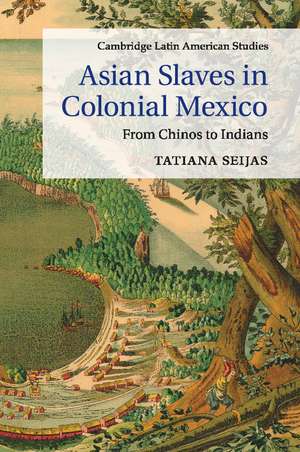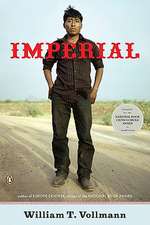Asian Slaves in Colonial Mexico: From Chinos to Indians: Cambridge Latin American Studies, cartea 100
Autor Tatiana Seijasen Limba Engleză Paperback – 13 mai 2015
| Toate formatele și edițiile | Preț | Express |
|---|---|---|
| Paperback (1) | 198.38 lei 3-5 săpt. | |
| Cambridge University Press – 13 mai 2015 | 198.38 lei 3-5 săpt. | |
| Hardback (1) | 695.06 lei 6-8 săpt. | |
| Cambridge University Press – 22 iun 2014 | 695.06 lei 6-8 săpt. |
Din seria Cambridge Latin American Studies
- 9%
 Preț: 593.09 lei
Preț: 593.09 lei -
 Preț: 231.54 lei
Preț: 231.54 lei -
 Preț: 236.92 lei
Preț: 236.92 lei -
 Preț: 188.27 lei
Preț: 188.27 lei -
 Preț: 236.99 lei
Preț: 236.99 lei -
 Preț: 322.67 lei
Preț: 322.67 lei -
 Preț: 289.01 lei
Preț: 289.01 lei -
 Preț: 526.45 lei
Preț: 526.45 lei -
 Preț: 209.07 lei
Preț: 209.07 lei - 11%
 Preț: 691.66 lei
Preț: 691.66 lei -
 Preț: 257.52 lei
Preț: 257.52 lei -
 Preț: 290.62 lei
Preț: 290.62 lei -
 Preț: 238.63 lei
Preț: 238.63 lei -
 Preț: 234.31 lei
Preț: 234.31 lei - 9%
 Preț: 594.05 lei
Preț: 594.05 lei -
 Preț: 156.72 lei
Preț: 156.72 lei - 14%
 Preț: 732.69 lei
Preț: 732.69 lei - 11%
 Preț: 591.79 lei
Preț: 591.79 lei -
 Preț: 325.38 lei
Preț: 325.38 lei - 11%
 Preț: 694.91 lei
Preț: 694.91 lei -
 Preț: 328.56 lei
Preț: 328.56 lei -
 Preț: 321.74 lei
Preț: 321.74 lei - 5%
 Preț: 306.74 lei
Preț: 306.74 lei -
 Preț: 287.07 lei
Preț: 287.07 lei -
 Preț: 284.98 lei
Preț: 284.98 lei -
 Preț: 287.66 lei
Preț: 287.66 lei -
 Preț: 284.39 lei
Preț: 284.39 lei -
 Preț: 318.84 lei
Preț: 318.84 lei -
 Preț: 287.28 lei
Preț: 287.28 lei -
 Preț: 191.51 lei
Preț: 191.51 lei -
 Preț: 322.51 lei
Preț: 322.51 lei -
 Preț: 236.72 lei
Preț: 236.72 lei
Preț: 198.38 lei
Nou
Puncte Express: 298
Preț estimativ în valută:
37.96€ • 39.54$ • 31.64£
37.96€ • 39.54$ • 31.64£
Carte disponibilă
Livrare economică 07-21 martie
Preluare comenzi: 021 569.72.76
Specificații
ISBN-13: 9781107635777
ISBN-10: 1107635772
Pagini: 300
Ilustrații: 9 b/w illus. 3 maps
Dimensiuni: 153 x 230 x 20 mm
Greutate: 0.44 kg
Editura: Cambridge University Press
Colecția Cambridge University Press
Seria Cambridge Latin American Studies
Locul publicării:New York, United States
ISBN-10: 1107635772
Pagini: 300
Ilustrații: 9 b/w illus. 3 maps
Dimensiuni: 153 x 230 x 20 mm
Greutate: 0.44 kg
Editura: Cambridge University Press
Colecția Cambridge University Press
Seria Cambridge Latin American Studies
Locul publicării:New York, United States
Cuprins
Introduction; 1. Catarina de San Juan: China slave and popular saint; 2. The diversity and reach of the Manila slave market; 3. The rise and fall of the transpacific slave trade; 4. Chinos in Mexico City: slave labor and liberty; 5. Joining the republic of Indians: free Filipinos and freed chinos; 6. The Church on chino slaves versus Indian chinos; 7. The end of chino slavery; Final conclusion.
Recenzii
'This important and enjoyable new addition to the venerable Cambridge Latin American Studies book series makes a resoundingly original contribution to the field. Seijas skillfully deploys archival sources on both the Philippines and Colonial Mexico, placing their analysis within a single, coherent framework. The result is fascinating; as the study unfolds, it effectively shifts our views of Asian slavery in Spanish America, of identity terms like chino, and indeed of race and ethnicity in early colonial Mexico.' Matthew Restall, Edwin Erle Sparks Professor of Latin American History, Pennsylvania State University
'Well-established forms of Filipino intertribal slave raiding along with swells of captives from the Indian Ocean and the wars against Islam in Mindanao transformed Manila into a bustling slave entrepôt by the mid-sixteenth century. For some 150 years, thousands of these 'chino' slaves left the Philippines for Mexico, where they became urban servants, artisan slaves-for-hire, pious beatas, and ultimately free Mexican 'Indian' vassals in the eyes of both civil and ecclesiastical courts. Paradoxically, the abolition of the Filipino slave trade by the late seventeenth century led to the ideological consolidation of African slavery, for the black body became the only sure legal marker to distinguish the true 'captive foreigner' in the body polity. This is a brilliant study of the rise and fall of the forgotten transpacific slave trade.' Jorge Cañizares-Esguerra, Alice Drysdale Sheffield Professor of History, University of Texas, Austin
'Focused on the trans-Pacific trade, Asian Slaves in Colonial Mexico illustrates the commercial and cultural linkages that tied New Spain to the global economy of the early modern world. By making chinos the subjects of this history, Tatiana Seijas rivets our attention on the human cargoes of the Manila galleon in their transit from the Philippines to New Spain and their gradual integration into colonial Mexican society. Built on a solid foundation of archival research, this innovative study examines anew the entwined themes of human bondage and the ambiguities of ethnic labeling through the pathways to freedom that were opened to enslaved persons in the far-flung imperial networks of the Iberian world.' Cynthia Radding, Gussenhoven Distinguished Professor, University of North Carolina, Chapel Hill
'Tatiana Seijas's book is long overdue. It is truly global in focus and comparative in reach. Steeped in archival sources, its study of early modern trans-Pacific slavery provokes comparisons with the trans-Atlantic traffic in humans during a contemporaneous and later period. Tracing the fate of 'Asian slaves' between Spain's two colonial spheres, the Philippines and colonial Mexico, this book is well-placed to contribute to a wide variety of fields, including comparative imperial formations and the growing historiography on slavery in East and Southeast Asian, Latin America and China. Its meticulous tracing of the lives of Asian slaves is a model for doing the social history of subaltern groups compelled to negotiate with colonial law, religious sanctions and permeable racial identities as they seek to move out of bondage and into emancipation prior to abolition.' Vicente L. Rafael, University of Washington, Seattle
'A short review cannot do justice to the many complex issues discussed in this superb and carefully researched early modern globalization case study. Students and scholars alike will benefit from the author's painstaking efforts to both track down traces of chino lives in archival documents and to contextualize their history within the expansive historiography of sixteenth- and seventeenth-century understandings on race and slavery.' Nicole von Germeten, The American Historical Review
'Seijas has provided an illuminating history from below of worldwide slavery and the Mexican caste system. The extensive archival research undergirding her study both strengthens its arguments and makes for a compelling read … This monograph is exemplary for anyone seeking to examine a regional issue within a wider historical context, for it shows early modern Mexico as the global crossroad that it was.' Ronald J. Morgan, Hispanic American Historical Review
'Well-established forms of Filipino intertribal slave raiding along with swells of captives from the Indian Ocean and the wars against Islam in Mindanao transformed Manila into a bustling slave entrepôt by the mid-sixteenth century. For some 150 years, thousands of these 'chino' slaves left the Philippines for Mexico, where they became urban servants, artisan slaves-for-hire, pious beatas, and ultimately free Mexican 'Indian' vassals in the eyes of both civil and ecclesiastical courts. Paradoxically, the abolition of the Filipino slave trade by the late seventeenth century led to the ideological consolidation of African slavery, for the black body became the only sure legal marker to distinguish the true 'captive foreigner' in the body polity. This is a brilliant study of the rise and fall of the forgotten transpacific slave trade.' Jorge Cañizares-Esguerra, Alice Drysdale Sheffield Professor of History, University of Texas, Austin
'Focused on the trans-Pacific trade, Asian Slaves in Colonial Mexico illustrates the commercial and cultural linkages that tied New Spain to the global economy of the early modern world. By making chinos the subjects of this history, Tatiana Seijas rivets our attention on the human cargoes of the Manila galleon in their transit from the Philippines to New Spain and their gradual integration into colonial Mexican society. Built on a solid foundation of archival research, this innovative study examines anew the entwined themes of human bondage and the ambiguities of ethnic labeling through the pathways to freedom that were opened to enslaved persons in the far-flung imperial networks of the Iberian world.' Cynthia Radding, Gussenhoven Distinguished Professor, University of North Carolina, Chapel Hill
'Tatiana Seijas's book is long overdue. It is truly global in focus and comparative in reach. Steeped in archival sources, its study of early modern trans-Pacific slavery provokes comparisons with the trans-Atlantic traffic in humans during a contemporaneous and later period. Tracing the fate of 'Asian slaves' between Spain's two colonial spheres, the Philippines and colonial Mexico, this book is well-placed to contribute to a wide variety of fields, including comparative imperial formations and the growing historiography on slavery in East and Southeast Asian, Latin America and China. Its meticulous tracing of the lives of Asian slaves is a model for doing the social history of subaltern groups compelled to negotiate with colonial law, religious sanctions and permeable racial identities as they seek to move out of bondage and into emancipation prior to abolition.' Vicente L. Rafael, University of Washington, Seattle
'A short review cannot do justice to the many complex issues discussed in this superb and carefully researched early modern globalization case study. Students and scholars alike will benefit from the author's painstaking efforts to both track down traces of chino lives in archival documents and to contextualize their history within the expansive historiography of sixteenth- and seventeenth-century understandings on race and slavery.' Nicole von Germeten, The American Historical Review
'Seijas has provided an illuminating history from below of worldwide slavery and the Mexican caste system. The extensive archival research undergirding her study both strengthens its arguments and makes for a compelling read … This monograph is exemplary for anyone seeking to examine a regional issue within a wider historical context, for it shows early modern Mexico as the global crossroad that it was.' Ronald J. Morgan, Hispanic American Historical Review
Notă biografică
Descriere
This book is a history of Asian slaves in colonial Mexico and their journey from bondage to freedom.









